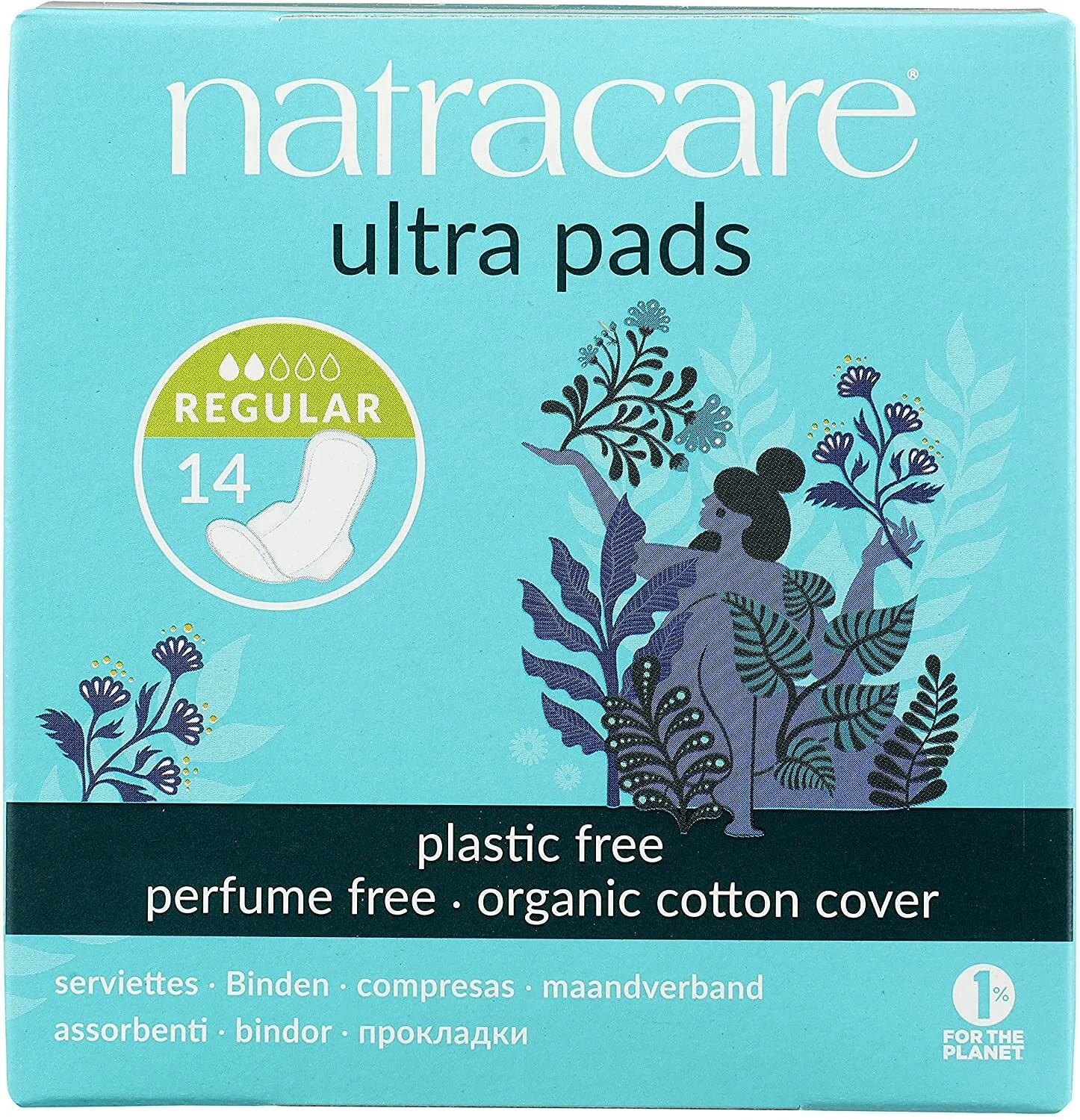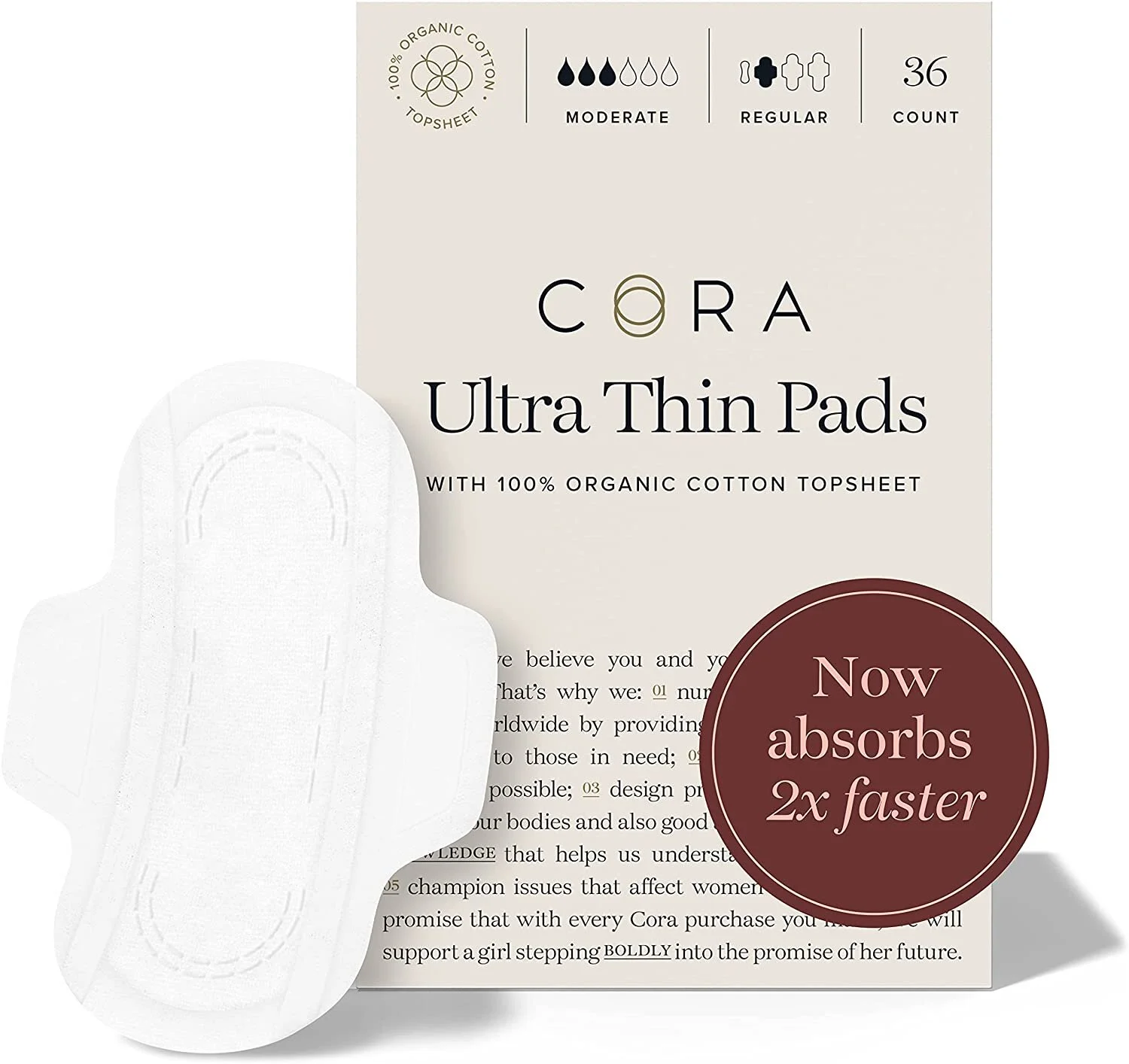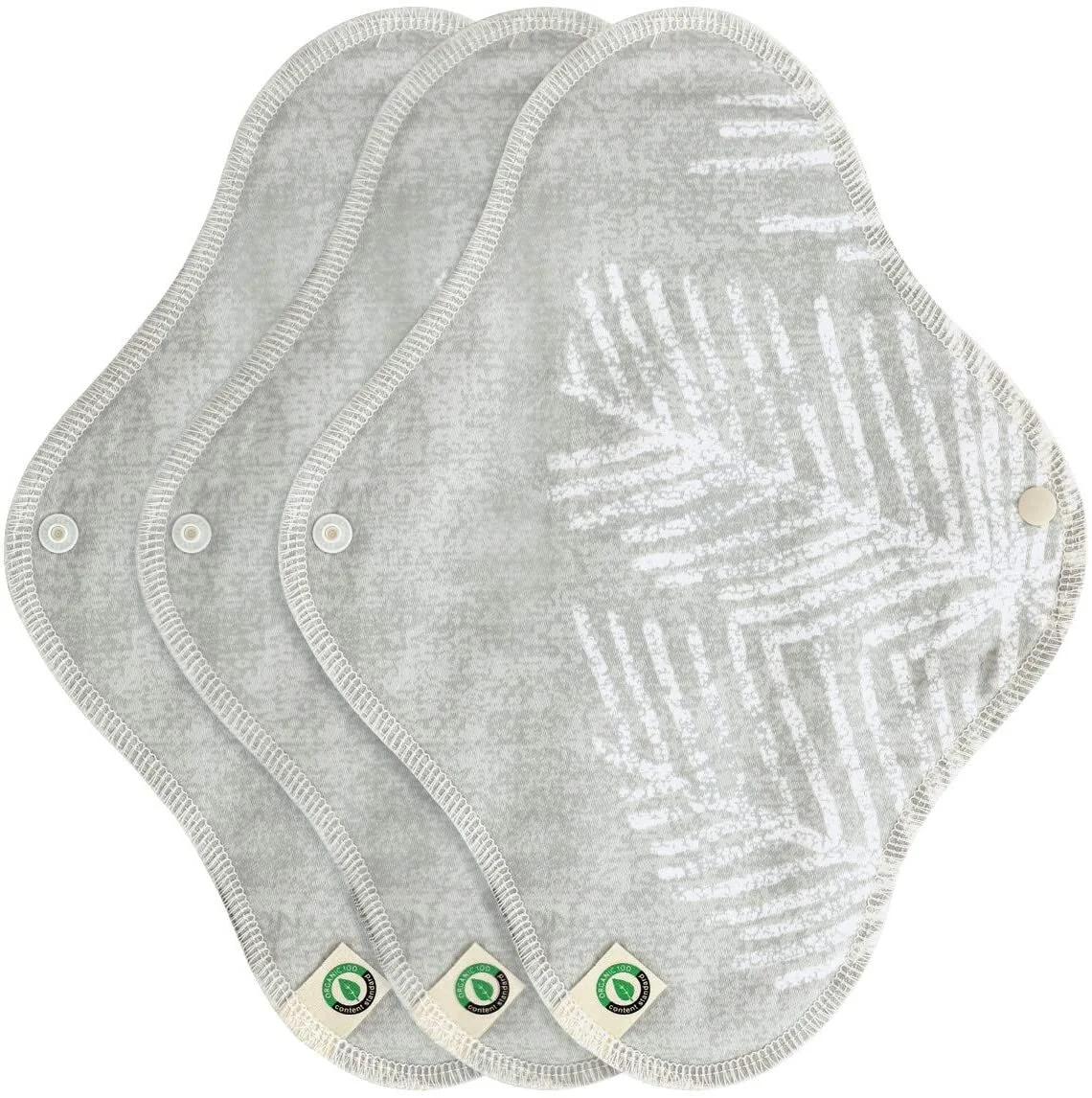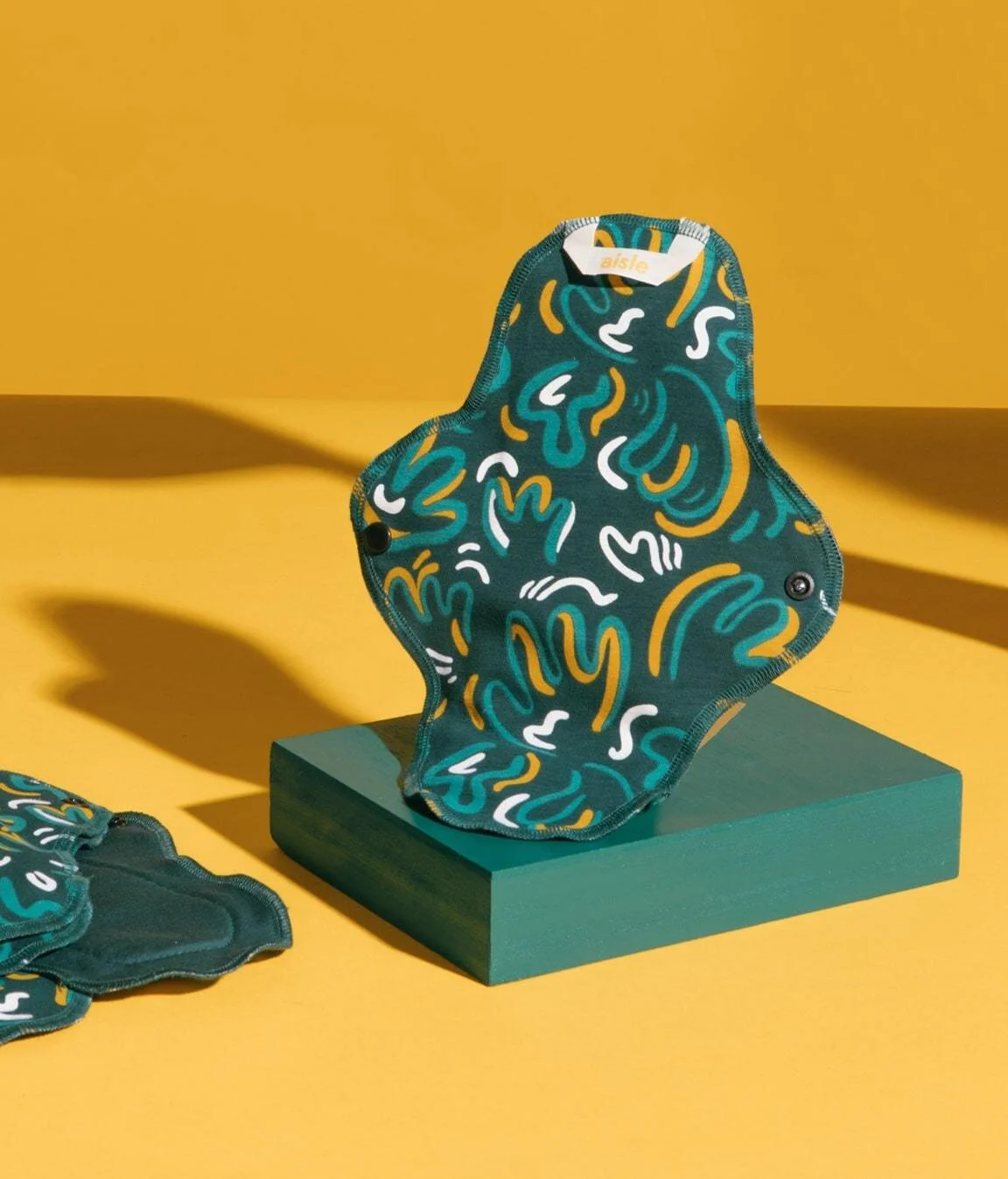Menstrual Pads
What’s white and plush and plastic all over? Menstrual pads! Yup, that’s right — from the sticky plastic “backsheet” (usually made of polypropylene or polyethylene), to the synthetic absorbent cores that soak up fluid, pads are up to 90% plastic. And we use a ton of them. In the U.S. alone, about 12 billion pads are discarded each year. That’s a whole lot of plastic that ends up as waste in our landfills. So how do you avoid this plastic mess? Let’s dig into the material considerations here.
What to be wise on:Periods and post-pregnancy leaks happen, and menstrual pads help keep our pants spot-free and prevent us from experiencing undue embarrassment during these times. But they also create a bunch of waste and can contain some pretty nasty chemicals that we definitely don’t want anywhere near our hoo-has. Well as it turns out, we don’t need the nasty chemicals and plastic waste in order to manage our flow when we’ve got our trusty friend Organic Cotton to help us through.
A FEW TAKEAWAYS: As a rule of thumb, go for plastic-free, chlorine-free, fragrance-free pads when you can. Organic cotton is better than conventional cotton, and conventional cotton is better than polyester or any petroleum-based material.
Ever heard of reusable pads? We’re here to tell you that they’re becoming a thing, and we’re on board. Reusable pads are a one-way ticket to reducing the amount of waste associated with those more traditional options. Just soak them in water when you’re done using them, and then throw them in the wash with the rest of your clothing. Ta-da! Good as new. And yes, the rest of your clothes will be fine. In fact, since the impact of a laundry cycle can be pretty high, we highly encourage you to be sure you’re washing your pads in a full load to avoid unnecessary water and energy waste. While the upfront cost of reusables is higher than that of disposables, you can use them over and over and over again, saving money over time.
TLDR: Just tell me what to look for.
Here are some of our favorite menstrual pad options based on price-point, materials used (read on below for why this is important), and customer reviews.
DISPOSABLENatracare Ultra PadsCost: $0.43 each
What we loveThese pads are chlorine-free, fragrance-free, plastic-free, and made with GOTS certified organic cotton. They are also MADE SAFE certified, which ensures they’ve been fully vetted for substances known or suspected to cause human and ecosystem harm. 75% of customers love them for their comfortable, non-irritating materials.
What could be better: These pads contain “non-toxic glue”. Since the phrase “non-toxic” isn’t regulated by the FDA and is frequently used in greenwashing tactics, we’re skeptical of this ingredient. And, some customers say that this adhesive glue doesn’t even work very well, so the pads don’t stay in place. Some also claim that these pads don’t absorb as well as other brands.
What we love:These pads are chlorine-free, fragrance-free, and made with GOTS certified organic cotton. They’re also made in the USA using renewable energy, which lowers their overall footprint due to the climate-water-energy nexus. 75% of customers love these pads, saying they are super comfortable and stay in place.
What could be better: Unfortunately, these pads contain plastic. Some customers say that the adhesive is TOO sticky, and is difficult to remove from undergarments.
reusableRael Organic Cotton Reusable PadsCost: $12.33 each
What we love:These pads are chlorine-free, fragrance-free, made with organic cotton, and can be reused up to 120 times. 67% of customers love these pads for their super-soft texture, breathability, and absorbency.
What could be better: There is a very small amount of polyurethane in these pads. Some customers say that they don’t stay in place as well as they’d hoped, and that the wings were not effective in keeping leakage out.
Think ECO Organic Reusable Cotton PadsCost: $6.96 each
What we love:These reusable pads are made of 95% organic cotton. We love that they are a more affordable option compared to most other reusable pads, and they can last for up to 5 years (we’ll call that at least 60 uses). 70% of customers love these pads, saying they are soft and lightweight.
What could be better: The company does not specify what the other 5% of the material is, but we’re guessing it’s polyester or another petroleum-derived material. These pads are made in Korea, so their shipping and transportation footprint is probably pretty high compared to pads made in the U.S. or Canada. Some customers also say that these pads are flimsy and don’t stay in place.
Aisle Maxi PadCost: $19 each
What We Love:These pads are made in Canada, which has low instances of workers’ rights violations. 86% of customers love these pads, saying that they’re super soft and comfy, absorbent, and easy to clean.
What Could Be Better:These pads contain some polyester and other petroleum-derived materials. Some customers say that they bunch up and move around too much.
THE FACTORS TO CONSIDER:Materials
Plastic (polyester, polypropylene, polyethylene)
From polyester in the soft, plush parts, to polypropylene and/or polyethylene in the sticky parts, plastic is the main component of most conventional pads. No, thank you! Plastic is made of petroleum, aka oil, which we extract from the earth’s crust by drilling and fracking. These practices have a host of negative environmental consequences that can devastate already fragile wildlife populations and expose people living and working near drilling sites to toxic gases and contaminated drinking water. Between the high heat and chemical refining processes required to make plastic, it’s one of the most energy-intensive materials to produce. Also, any plastic that ends up in our environment breaks down into microplastics, which have been found at the top of Mount Everest and the bottom of the Mariana Trench...and could be impacting you, me, and the environment in ways we never saw coming. Let’s avoid that.
Cotton
For pads, we love cotton. It’s soft, breathable, and absorptive -- the ideal characteristics of a period-catching instrument. Unfortunately, conventional cotton is a water-intensive crop that takes a significant toll on the soil and is associated with deforestation and heavy pesticide use. Almost 10% of all agricultural chemicals and 25% of all insecticides come from the cotton industry. But, not all cottons are created equal. Choosing organic cotton will lower the likelihood that your purchase is associated with the use of these chemicals, which end up poisoning our soil and waterways, and can lead to endocrine disruption. Go the extra mile by choosing cotton certified by the Global Organic Textile Standard (GOTS), the most stringent textile certification ensuring that the product complies with environmental and social criteria along the entire supply chain. As for conventional cotton -- despite the imperfections of the industry, it’s way better than anything petroleum-derived.
Chlorine bleach
Pads are often treated with bleach to achieve that super-clean white and fluffy look. We recommend looking for chlorine-free or unbleached pads, since bleach can contain dioxins and furans, which are known to cause cancer, endocrine disruption, and reproductive toxicity.
Fragrances
Because fragrances are considered trade secrets, pad manufacturers aren’t required to tell you everything that goes in their products to give it that fresh scent. This means that pads with “fragrance” could contain a host of nasty chemicals like phthalates and synthetic musks, which are known to disrupt hormones and can lead to developmental and fertility problems. Steer clear for the sake of your hoo-ha.
End of life
End of life considerations vary significantly here depending on whether you choose disposable or reusable pads. About 12 billion pads are thrown away annually in the U.S. alone, and none of them are recyclable. The cumulative impact of that waste weighs on our landfills, which already receive over 146 million tons of trash per year. Rather than lasting a few hours, reusable pads generally last up to five years. This means that if you replaced every disposable pad with a reusable pad and washed them all once per cycle in a full load of laundry, you could reduce the amount of material solid waste associated with your period by up to 98%. Pretty groovy, huh?






